
USS United States (1949) – The atomic carrier
Cold War USN Carriers:
Essex SBC-27 class | Saipan class CVs (1945) | Midway class | USS United States | Forrestal class | Kitty Hawk class | USS Enterprise | Nimitz class | Gerald Ford classAssault Carriers:
Iwo Jima class | Tarawa class | Wasp class | America class | SCS class | VSS classThe missing link between the wartime Essex class fleet aircraft carriers, the next-gen Midway, and the supercarriers of the 1960s was a near-forgotten ship class that was projected under the Truman administration and that would have easily dwarf any other warship on the planet for the decades to come, with a displacement of over 80,000 tonnes and lenght of 332 meters (1090 feets overall). The lead ship of this class was aptly named – USS United States. A fitting name for a 4 of july post…
Despite its relatively advanced design, the US class became significant in overall US carrier development. They were -despite obvious differences – progenitors of the Forestal class and their successor and their dimensions and tonnage was match by the USS Enteprise, laid down ten years afterwards. In between a quick review of both designs (especially the flight deck) revealed the enormous technological gap. The latter had nuclear propulsion, no armament whatsoever but its air group, a massive flight deck almost twice the width, three large overhanging lifts, and a brigde that would have been unrecoignisable for sailors in 1950. On the contrary, the United States could not offer more contrast: Heavily armed and armoured, narrow, with classic battleship style powerplant and no island… This alone says volumes about the staggering development speed of US carrier design after WW2. Not peacetime normal evolution, and for good reasons since 1947.
As a side note, the product of this was called CVA 58 (the only one ship ever called that way), which cries for explanations: To distinguish aircraft carrier (so “AC” for everybody but), from colliers (A standing for Auxiliaries) or “CA” reserved for armoured cruisers (Cruiser, Armoured). The navy decided to call aircaft carriers “CV” for “Carrier, Voler” (pardon my french – this means “flying”). Hence the CVE (E for escort), CVN (N for Nuclear) and ultimately CVA, the last for “Atomic”. Not for atomic propelled bombers, but in the sense of an atomic weapon delivery system. You’re welcome.
Genesis of the project
Despite some WW2-related aspects, the USS Unitesd States class was developed with a single, simple goal in mind: Projecting power at sea, but not a standard versatile air group, but carryong the newly developed strategic bombers of the USAAF. It was tailored for strategic operations to carry heavy four-engine B-29 or their successors, a bit like the Hornet with B-25s in 1942. Curtis LeMay’s SAC (Strategic Air Command) was founded on March 21, 1946, but as usual, the USAAF and Navy did not get along always well and the proposal was not overly enthusiastically received.
Of course the idea came from the Navy, not the USAAF: The chief proponent for this new new large carrier was Admiral Marc Mitscher. He wanted in 1946 a carrier able to handle the latest and most effective planes of the day. Early design discussions focused naturally around new jet aircraft, faster, larger, heavier and thus requiring an updated platform compared to the Midway-class generation. One of the advantage of the jet was its supposed longer range, allowing the carrier to operate farther away from the target. For the new aircraft carried it was agreed the deck would have to be longer and much reinforced to handle the weight of these jet aircraft landing. Catapults were to be also longer and more powerful, as the arresting systems and lifts. The project evolved in 1947-48 with several proposals and back-and-forth propositions betwen the admiralty and BuShip.
Design
The strengthened deck (armoured) originally the hangar deck, was replaced higher to the the flight deck and it was chosen to in the end not to have no extra armor for it, for that would have created a greater tendency to roll in rough seas, with critically dangerous a metacentric height. Instead, armour was eliminated for good. It was believed that due to the nature of the payload (heavy strategic bombers) the new carriers would remain far away from any possible counterattack. In any case, at 33 knots and heavily armed, and keeping presumably a set of fighter jets used for an extensive CAP, plus radar warning, there were still layers of defense to pass.
Based on the new jet aircraft to carry, the design was made flush deck quickly, but due to large planes operations it became self-evident the island was a nuisance and it was felt safe to elimnated completely the control structure. Instead radar antennas, telemeters, FCS and the rest of what an island carrier was relegated to the two flight deck side sponsons, port and startboard. No island meant also no vertical funnel ducting and instead, they were truncated into two side funnels installed mid-ship under the flight deck, but far away from the hull with extensions to avoid smoke interference, notably in case of landing operations.
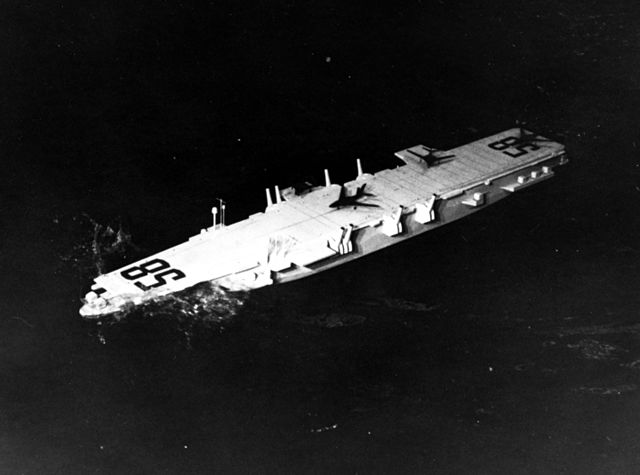
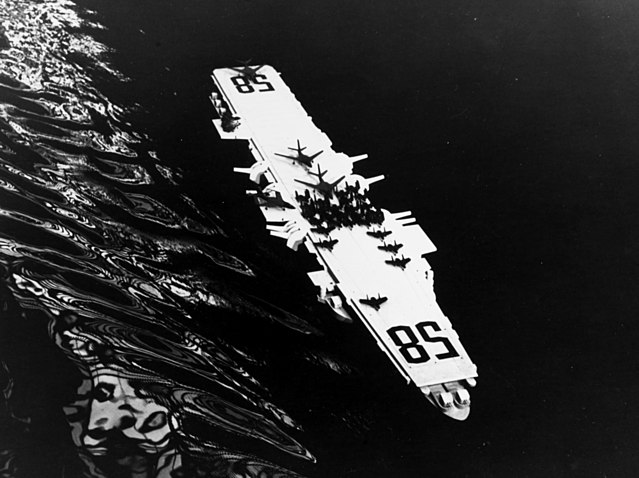
USS United States model undergoing seakeeping tests at Carderock Navy test pool circa 1947. Note the fighters showed there was the mediocre Cutlass, but the jet bomber is completely unknown. Nothing resembled it in 1947 and it looks really advanced for the time, in its overall shape, almost a Rockwell B1. The model is also interesting for other points: The “gun-like” tubes which seem to protrude from masks were elevated funnels, which could be oriented to deflect smoke from the deck in any wind conditions. This was not kept for the final design. The deck looks also quite straight, with just forward catapults.
In these dicussions, it soon apparead that this radical no-island flush-deck design carried two major concerns: Smoke diversion from the flight deck remained a problem no early carrier (the 1920s generation) never really solved before raising it into large islands, and of course was the placement of early warning radar equipment, which needed some free room free from interference. If aerials were carried they needed to be small and placed low.
One solution proposed was to have the ship escorted by a specialized command ship, carrying the commander of the task force, and having the best and largest detection radars. This command ship would radio electronic information and orders from its command center, relegating the carrier as a simple “carrier” executant.
A second solution was to provide the carrier some specialized aircraft that be used as early warning radar warning in the air, detecting incoming aircraft over a large area. This was the germ for early warning carier-borne radar aircraft, such as the E-1 Tracer , but it would not be available before… 1956. In 1949, when the ship entered service, the only available, not-carrier operated, were the massive Lockheed WV and EC-121 Warning Star derived from the super constellation. Some hoped to adapt it to be carrier-operated as were future strategic bombers for this new aircraft carrier.
In the end, as for its core concept, the new CVA-58 class was to be design not to safely operate by itself, but in a larger task force, with traditional fleet carriers in complement. It was really reduced as a bomber carrier and could do little else, it was just an extended strategic arm within a larger force. In addition it was dependdent of what aircraft types would be in existence in the 1952-1960 era, the reasonable career expectancy for such concept. And we know how it went.

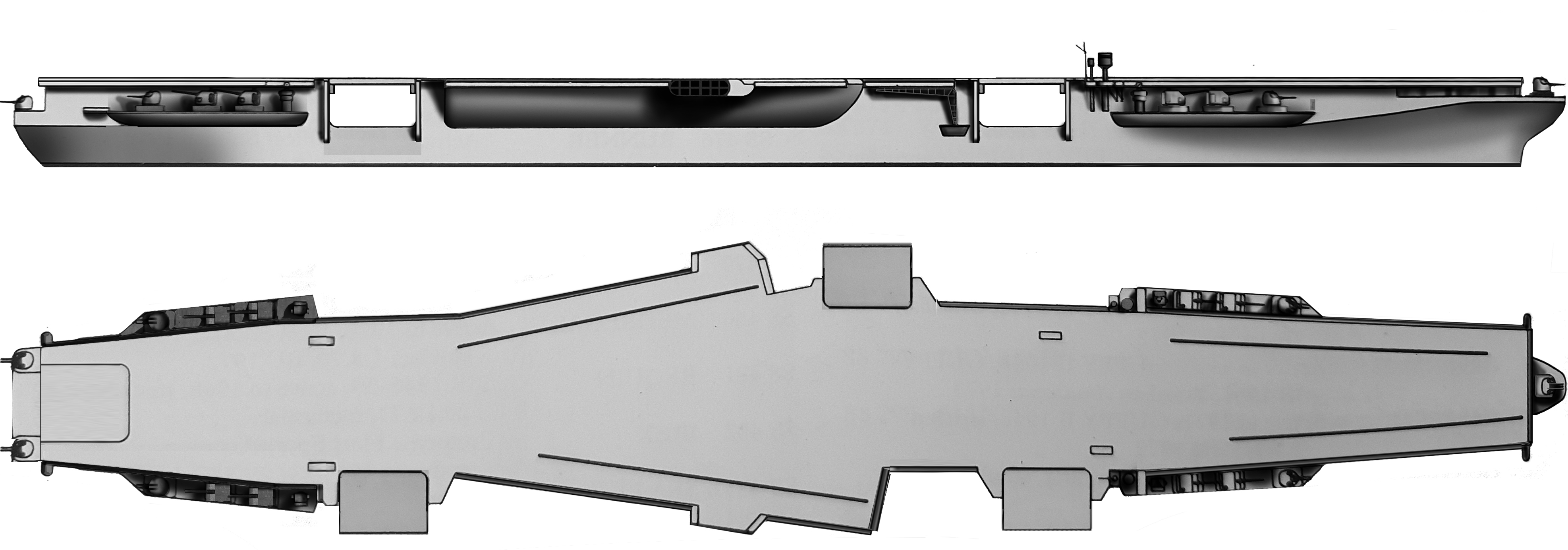
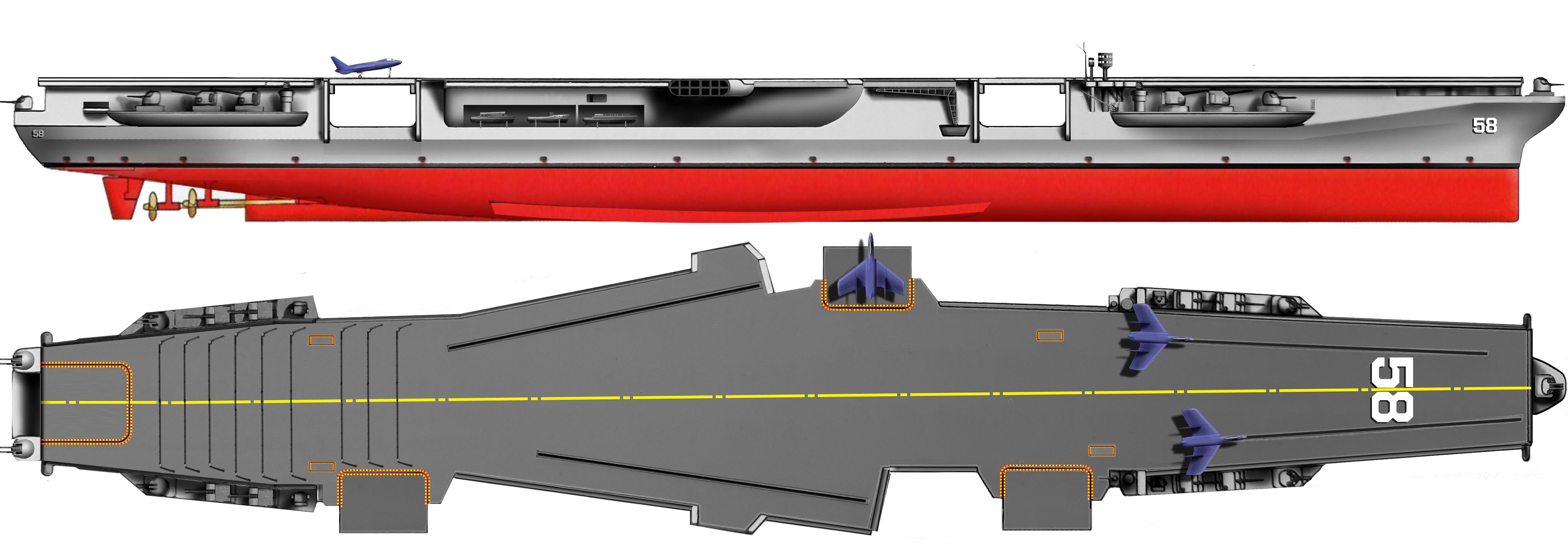
Colorization of the conway profile, rendition by the author with Vought Cutlasses for scale.
Final design general specs
As it appeared finalized and approved by president Truman on 29 July 1948, the new “supercarrier” (fist time the term was coined) was estimated to be around 66,434 tonnes standard, for 78,946 tonnes on trials, and up to 83,249 tonnes loaded for war operations, with its full air group. This was considerable compared to the Midway class (59,000) and remained above the following Forrestal and Kitty Hawk. The overall lenght was conditioned by the advent of a non-catapulted launch, with a few strategic bombers starting from the end of the aft landing deck and running about 300m with some extra help (rocket boosters). The ship measured 1088 ft (331.7 m) long overall and 1030 feets (314 m) at waterline level. At the time, having large air groups and their management on the flight deck made no sense: Strategic bombers needed to take all the space available, with possibly extra planes in the hangar, and fighters too.
The hull design however was made for speed, getting best advantage of a near-300,000 hp powerplant. It was 125 feets (38,1 m) wide at the waterline, for a near 1/10 ratio similar to cruisers and destroyers. Of course the flight deck was way larger, extended by using overhanging structures as much as possible and reached 190 feet (57.9 m) at its widest extension, at the level of the two side funnel tips port and starboard. The design was also peculiar in that it had no less than four hydraulic catapults installed: Two forward, in échelon to avoid intereferences when launching, and two mid-ships in extensions above the funnels, and oblique, port and starboard. They corresponded each to a pair of lifts: Two forward, including one starboard and one port midship, both overhanging. They served the two forward catapults. A third one was placed aft, just before the sponson starboard, and the fourth was a “classic” centerline, larger lift placed at the stern deck. The design gave dimensions hardly compatible with heavy strategic bombers, so we can assume the development of a carrier-borne wings-folding nuclear bomber was in the works at that time: It became ultimately the A5 Vigilante, which development started in the early 1950s.
Powerplant
CVA 58 did not need something very innovating at that time. There were discussions about adapting nuclear power to provide electricity but it’s was still at experimental stage. The world’s first artificial nuclear reactor, Chicago Pile 1, was experimented on 2 December 1942, but it produced just some voltage measure. The first nuclear reactor to produce electricity experimentally was the small Experimental Breeder reactor (EBR-1) designed and operated by Argonne National Laboratory, Idaho, USA, started up in December 1951. Soon, benefiting from the 1953 President Eisenhower proposed “Atoms for Peace” program, budgets were allocated. But this was the Navy that pushed things forward with Admiral Hyman Rickover, pressing developement of the pressurised water reactor (PWR) for naval use. Its Mark 1 prototype started in March 1953 in Idaho, and later propelled the first nuclear-powered submarine, USS Nautilus, launched in 1954. In 1958, there was now a craze to adapt it to all USN major surface vessels as well. That was the start of the “New Navy” resting on nuclear and missile.
But not at a time USS United States was studied. In 1946-47, the only realistic plant could only be the one from the latest battleship planned (the montana class) or the Midway class, albeit buffed up. Eventually, engineers settled on using Eight 1,200 psi (8.3 MPa) Foster-Wheeler boilers, connected to four Westinghouse steam turbines totaling 280,000 hp (209 MW). They drove four 20.5 ft (6.2 m) diameter screws. By comparison, the Midways with the same Westinghouse Steam turbines used 212,000 shp (158,000 kW), so that was a substantial increase. The goal was of course to maintain a constant high speed for the task force, in order to strike and retire, staying out of harm. Top speed therefore was the same 33 knots (61 km/h) as for the previous CV. Compartimentation was the same as previous designs, made to delay and stop any ASW damage flooding, with extra buoyancy and void compartments.
Armament
That aspect was surely the most “WW2” aspect of the design. Of course it was not thought to be used for naval combat, the air group and task force ensures the right level of protection for this, but rather to provide at least a layer of closer AA protection. The hull was large enough to accomodate generous sponsons at the angles, and the admiralty was still anxious about heaving a carrier devoid of any self-defense. This will change only with USS Enterprise. Indeed, like CVA 58, the next class, Forrestal (CV-59) was given eight 5 in (127 mm)/54 caliber Mark 42 guns in sponsons, in the same way, as the CV-63 at initial phases of development, until the sea sparrow was planned instead.
USS United States therefore carried a generous armament still reminiscent of the Midway class, with eight 5 in (127 mm)/54 caliber guns in single mounts (four single in turrets port and starboard mounts), same models as for the USS Midway, and sixteen 76 mm/70 caliber guns in eight twin mounts. They were placed also on the same sponsons, one of each (so four), two aft (either side of the lift) and two forward (side by side on the bow deck), althought drafts shows there a single, but larger turret (possibly quadruple). It’s not clear at this point. Artist’s views and test models all shows a single standard turret, meaning seven turrets, not eight. Another aspect whis was also drived from the Midway and WW2 experimence was a battery of twenty Oerlikon 20 mm cannons, probably placed in deck-level side sponsons, perhaps as an afterthought. Ten could have easily took place along each side of the forward flight deck.
Artist impressions of the carriers are misleading (but that’s no surprise): For example, an early sketch navy shows shorter sonsons and only the 5-in guns, not bow turret, and 40 mm Bofors along the forward flight deck. The Carderock Navy test shows eight orientable funnels amidships, two 5-in in fwd side sponsons, six in aft sponsons, two at the bow, two aft. No details for lighter AA. The Popular Science 1949 cover shows four old style 5-in/38 turrets per side, and 20 mm guns forward plus a bow turret. To control the main guns, four telemeters were installed at the rear of each sponsons.
To control air operations, there were two towers on the right side, aft of the first sponson. It shows in succession a large two-storey cylindrical tower, a small one-stage tower, and a mast, reinforced to carry the stated electronics, an SPS-6 semi-circular radar and an SPS-8 dish array. The mast, as shown in the post’s main artist impression picture, by far the most precise and accurate, its a tripod, with an extension aft for the SPS-8 and carried a platform for both the SPS-6 and another unknown dish array, plus communication antennae and service rigging. The tower itself, assumed to be a substitute for a proper bridge, although tiny, coud be enough to carry basic navigation and observation equipments.
Conjectural air group
For proposed operations the USS United States was designed with carry long-range bomber aircraft, at the time still undefined. The latter had just to be large enough to carry a heavy load, nuclear bomb intended. But they needed to have long range escort fighters as well. The Navy wanted also the design to provided other roles, such as providing air support for amphibious forces and conduct classic sea control operations as well, but they came as secondary. The “bomber carrier” concept operating in a task force was coupled with traditional attack carriers in any case, that could protect her with their own air groups from any threats. They were to provide the main air cover for the whole task force. This, however, proved the CVA-58 it’s undoing and this dependence from the USAAF to provide the adequate bomber, made virtually the ship would become a target of inter-service rivalries, both over missions, and funding (see later).
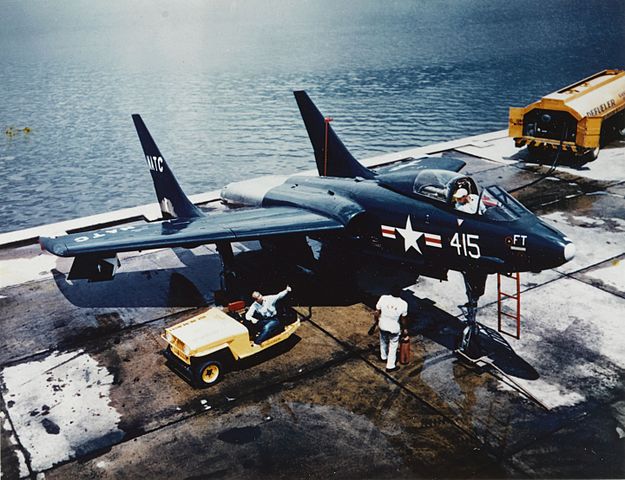
Vought F7U-1 Cutlass at NAS Patuxent in 1950, likely the first fighter jet aboard CVA 58. Other candidates shown on the artists views are the Mc Donnell Douglas Banshee, and a prototype long-range, four-engine reconnaissance prototype that was chosen by PopSci for its cover (and another artist’s view), as sleek fantasy bomber. None shows the B-29, but unidentified four-engine planes.
Now back to the hypothetic air group. On paper, the 1949 specs shows the carrier carrying 12 to 18 heavy bombers and 54 jet engined fighter aircraft, according to Elward, Brad (2011). Nimitz-Class Aircraft Carriers. Osprey Publishing. pp. 6–8. Their type is unknown, however the project 6A, arrangement study 4 (see above), shows two types of folding wings twin-engine “bombers”. The large ones, at the front, appeared to look like the Lockheed P2V Neptune, which was available at that time and worked on for that role. It was able to carry a heavy payload over 2,100 miles (3,400 km) and was proven able to take off from USS Franklin D. Roosevelt in 1951, with rocket assistance.
In fact a while programme was started by the Navy to develop a carrier-borne nuclear-capable bomber: The US Navy in fact planned to acquire this nuclear strike capability in 1945, to maintain its political influence in the peacetime context of budget restraint. The carrier-based aircraft needed however a payload smaller than the large “Fat Man” and the US Navy Bureau of Ordnance decided to take on 25 outdated but more compact “Little Boy” nuclear bomb designs instead. They started tests inside the P2V Neptune bomb bay. The latter was an accepted Navy Bomber, at a time the USAAF wanted to restruct the navy access to these. There was enough fissionable material available by 1948 to build ten complete uranium bombs but only initiators for six. The U.S. Navy also modified the P2V Neptune using assisted takeoff (JATO) and started testing this in 1948. However, the Neptune could not land on a carrier, still. Landing on a friendly land base after strike or ditch at sea were the only options. Eventually the cancellation of the USS United States led to the cancellation of this programme for the PV2.
The North American AJ Savage (Int. September 13, 1949) replaced it eventually in the 1950s, but it was also short-lived, replaced by the Vigilante.
The smaller bimotor, also from this plan, looks like the Grumman F7F Tigercat. The latter was specifically designed on Navy specs to operate as a long-range escort fighter already in 1942 to escort the B29 bombers over Japan from carriers. It first flew on 2 November 1943, was introduced in 1944 and still was available to act as so for the hypothetic naval bomber the navy waited for in 1949. The Tigercat was used in Korea as a night patrol fighter but retired in 1954, doomed by the jet age.
From FAS

Various details for the Navy concept, notably the small tower bridge and the deck edge glassed observation posts.
After several years of planning, on 29 July 1948 President Truman approved construction of a “supercarrier”, for which funds had been provided in the Naval Appropriations Act 1949. This first postwar carrier was laid down in April 1949. The flush-deck 65,000-ton CVA 58 United States was designed to launch and recover the large aircraft of 100,000 pounds required to carry early nuclear weapons, which weighed as much as five tons. The ship was to be over 1000 feet long, without an island, and of a radical new design. The construction cost of the new ship was estimated at $190 million, with the additional thirty-nine ships required to complete the accompanying task force estimated to cost $1.265 billion. The United States was also intended to provide tactical air support for air and amphibious forces and to conduct sea control operations. But the general perception was that the United States was primarily intended as a platform for long-range nuclear bombardment. The Air Force viewed the United States as the embodiment of the Navy’s nuclear aspirations as an attempt to challenge what had been an effective Air Force monopoly on strategic nuclear weapons delivery. A majority of the JCS maintained that the super carrier’s main function would be a duplication of the primary role of the Air Force. In the face of limited budgetary resources, and responding to opposition from the Army and Air Force, Defense Secretary Louis Johnson announced on 23 April 1949 the cancellation of construction of the United States. This prompted the immediate resignation of Navy Secretary John Sullivan.
This marked the beginning of a major onslaught on Navy funding. The fiscal constraints placed on the military in the late 1940’s were severe, and plans debated in the summer of 1949 for the Fiscal Year 1951 budget called for deep cuts in naval aviation. Operational Essex Class carriers were to be reduced from eight to four, Carrier Air Wings from fourteen to six, operational Saipan Class carriers from ten to eight, Marine Squadrons from twenty three to twelve, Anti Submarine Warfare Squadrons from eight to seven, and Patrol Squadrons from thirty to twenty. While the Navy was struggling to maintain its carrier fleet, the Air Force was pushing for a seventy-group bomber force.
The famous “Revolt of the Admirals” cost Admiral Denfield his position as CNO, but it saved carrier-based naval aviation. The first atomic bombs went to sea on the USS Franklin Roosevelt in 1950. The Navy’s inability to convey carrier doctrine to policy makers negatively effect America’s preparedness for subsequent wars and conflicts of a limited nature. It would take the accumulated experience of numerous limited engagements, and more particularly, the Vietnam War, for defense planners to recognize anything approaching the full potential of the carrier. Source.
Fate and inheritance
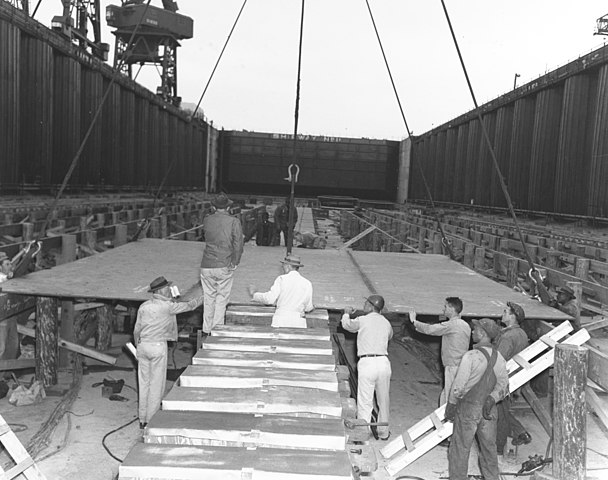
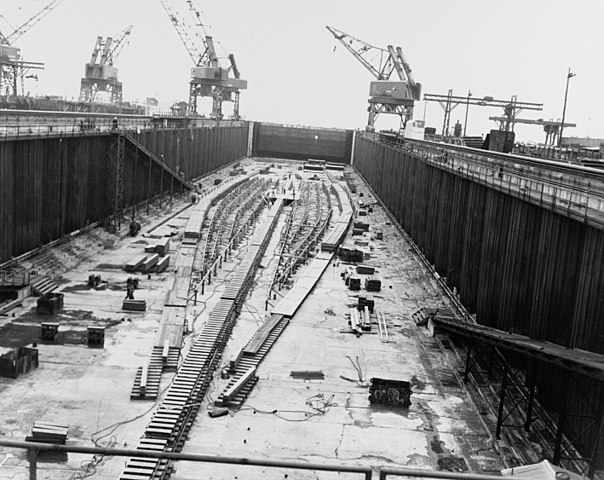
Commencement of construction, first keel plate laying, 18 April 1949
Truman approved construction on 29 July 1948, which took place after many design revsions and finding the right contractor at Newport News Drydock and Shipbuilding, declared the winner, on 18 April 1949. The first steel keel plate was laid down in a small ceremony. Construction went off for just five days, just the time to prepare the scaffolding for the hull bottom plates and assemble a few plates. But between the Pentagon and the white house, a war raged.
The very nature of the USS United States, apparently independent of USAAF nuclear-bombers soon antagonized the United States Air Force and in particular Curtis LeMay’s SAC, as a challenge to their monopoly on strategic nuclear weapons delivery. In the end, the Navy was out-done by internal politics. Secretary of Defense Louis A. Johnson was apparently acquired to the USAAF’s ideas of maintaining a strict monopoly on nuclear deterrence by means of large, long-range bombers. Always looking to cut down military budgets, Johnson accepted without question the Air Force arguments; Eventually, he cancellation of construction of USS United States was pronounced on 23 April 1949, just five days after the keel laying. Secretary of the Navy John Sullivan immediately resigned in protest. The Congress held an inquiry into this and Johnson’s apparently rash decision. Indeed, until the keel was laid down, considerable effort had been made, studies, teams working around the clock both at the yard, BuShip, the pentagon and admiralty on this project wanted and approved by truman (and the congress which authorized the ordered on year earlier). Considerable sums had been engaged since three years. Of course that slap by the USAAF angered the admiralty, leading to the subsequent “Revolt of the Admirals”: In the end the Navy was unable to advance its case that large carriers could be essential to national defense.
Johnson and Francis P. Matthews, Johnson’s choice to be the new Secretary of the Navy, started to punish all publicly opposing admirals, and the first to pay the price was Admiral Louis Denfeld, forced to resign as Chief of Naval Operations. By solidarity other voices were heard, and many other admirals and officers of lesser ranks were punished, sacked or retired. The invasion of South Korea, six months, operated an electroshock and immediately urged for a strong naval presence. Matthews’ position as Secretary of the Navy was wildly contested and he was force to resign, as was his patron, Johnson, as Secretary of Defense. The Navy would have it’s revenge umtimately: At first by having nuclear weapons carried onboard the aircraft carrier USS Franklin D. Roosevelt in 1950, and the planes to deliver it. Still, the question of which service would have primary responsibility for strategic nuclear strikes was not resolved, that is until it was solved not with bombers, but with submarines, thanks to a man not at first always liked by the admiralty, H. Rickover, and the nuclear ballistic attack submarine, now considered the bedrock of nuclear deterrence, more effective than bombers that were superesded by ballistic missiles in the 1960s.
The concept of large air base for bombers was not new, it dated from the 1930s already and between Churchill’s Habakkuk and other fantasy oceanic platforms that never see the light of day, it stayed a powerful concept until technology made the concept of bomber as a delivery way, obsolete, too vulnerable. Essentially nuclear deterrence delivered by that way was maintained in the Navy as a capability in all its carriers, using large jets such as the Vigilante at first, until it became purely theoretical. What layed behind the USS United States concept was, by all accounts, a ww2 concept. Technology development ensured the idea has no future at a time ballistic missile can hit any point on the planet, almost from any point.
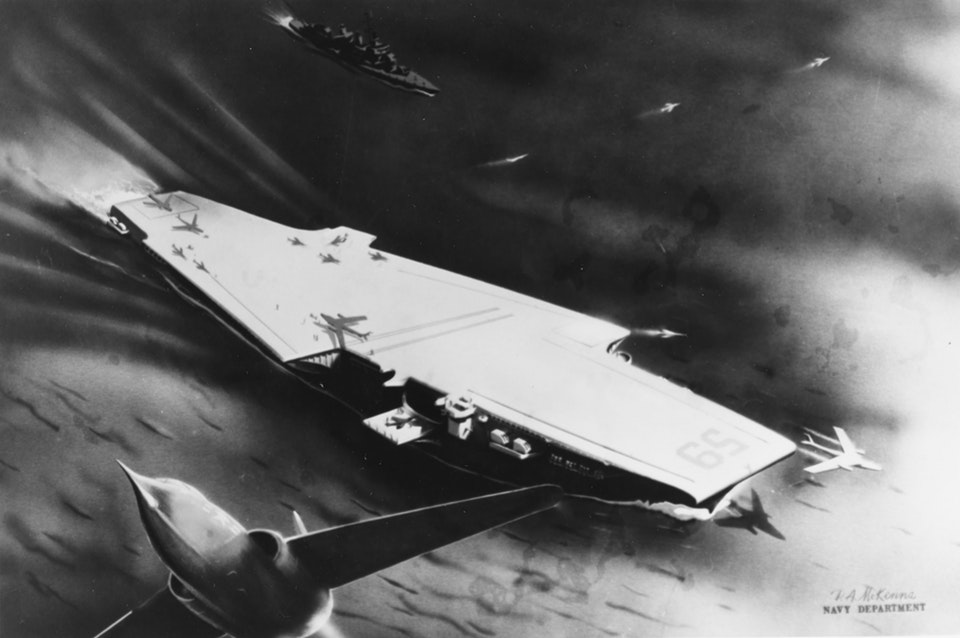
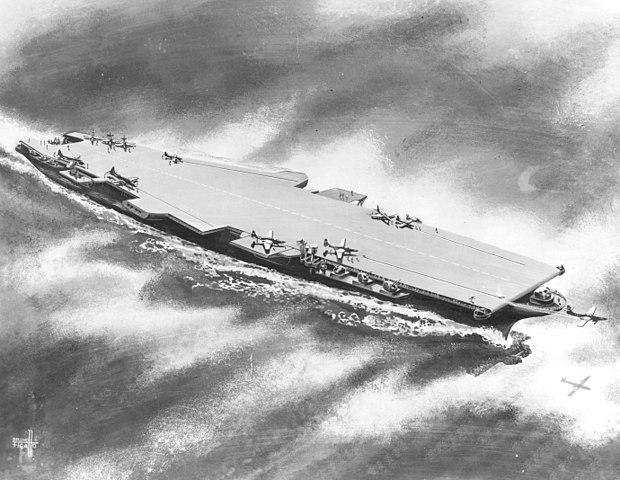
Artists Conception of the USS United States (CVA-58), the Lead Ship of a new class of Carrier, whose Keel was laid and then cancelled 5 Days later. LIFE Magazine, May 2, 1949
Characteristics:
Displacement: 66,434t standard 83,249t FL.
Dimensions: 331.7m oa x 57.9m oa x 10.5 m (1088 x 190 x 34ft 6in)
Propulsion: 2 shafts geared turbines, 4 boilers, 280,000 hp and 33 knots max. 12,000 nm/20kts
Crew: 4,127
Embedded Electronics: SPS-6, SPS-8
Armament: 8x 5-in/54, 8×2 3in/70, 20x 20mm, 150 planes?
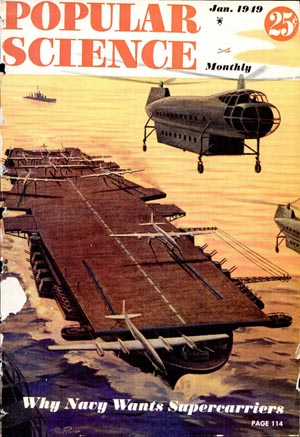
Links/Src
Friedman, Norman U.S. Aircraft Carriers: An Illustrated Design History
McFarland, Keith (1980). “The 1949 Revolt of the Admirals” (PDF). Parameters: Journal of the US Army War College Quarterly
Polmar, Norman (2008). Aircraft Carriers: A History of Carrier Aviation and Its Influence on World Events: Vol. II, 1946-2006. Dulles, Virginia: Potomac Books, Inc.
Dictionary of American Naval Fighting Ships.
Jared A. Zichek: The Incredible Attack Aircraft of the USS United States, 1948–1949. Atglen, PA: Schiffer Publishing, 2009
.
On navsource.org
On navysite.de
On History and Heritage Command
On hyperwar
Popular Science article on CVA 58.
On secretprojects.co.uk
Model kit: 1/700 blue ridge models


 Latest Facebook Entry -
Latest Facebook Entry -  X(Tweeter) Naval Encyclopedia's deck archive
X(Tweeter) Naval Encyclopedia's deck archive Instagram (@navalencyc)
Instagram (@navalencyc)





 French Navy
French Navy Royal Navy
Royal Navy Russian Navy
Russian Navy Armada Espanola
Armada Espanola Austrian Navy
Austrian Navy K.u.K. Kriegsmarine
K.u.K. Kriegsmarine Dansk Marine
Dansk Marine Nautiko Hellenon
Nautiko Hellenon Koninklije Marine 1870
Koninklije Marine 1870 Marinha do Brasil
Marinha do Brasil Osmanlı Donanması
Osmanlı Donanması Marina Do Peru
Marina Do Peru Marinha do Portugal
Marinha do Portugal Regia Marina 1870
Regia Marina 1870 Nihhon Kaigun 1870
Nihhon Kaigun 1870 Preußische Marine 1870
Preußische Marine 1870 Russkiy Flot 1870
Russkiy Flot 1870 Svenska marinen
Svenska marinen Søværnet
Søværnet Union Navy
Union Navy Confederate Navy
Confederate Navy Armada de Argentina
Armada de Argentina Imperial Chinese Navy
Imperial Chinese Navy Marinha do Portugal
Marinha do Portugal Mexico
Mexico Kaiserliche Marine
Kaiserliche Marine 1898 US Navy
1898 US Navy Sovietskiy Flot
Sovietskiy Flot Royal Canadian Navy
Royal Canadian Navy Royal Australian Navy
Royal Australian Navy RNZN Fleet
RNZN Fleet Chinese Navy 1937
Chinese Navy 1937 Kriegsmarine
Kriegsmarine Chilean Navy
Chilean Navy Danish Navy
Danish Navy Finnish Navy
Finnish Navy Hellenic Navy
Hellenic Navy Polish Navy
Polish Navy Romanian Navy
Romanian Navy Turkish Navy
Turkish Navy Royal Yugoslav Navy
Royal Yugoslav Navy Royal Thai Navy
Royal Thai Navy Minor Navies
Minor Navies Albania
Albania Austria
Austria Belgium
Belgium Columbia
Columbia Costa Rica
Costa Rica Cuba
Cuba Czechoslovakia
Czechoslovakia Dominican Republic
Dominican Republic Haiti
Haiti Hungary
Hungary Honduras
Honduras Estonia
Estonia Iceland
Iceland Eire
Eire Equador
Equador Iran
Iran Iraq
Iraq Latvia
Latvia Liberia
Liberia Lithuania
Lithuania Mandchukuo
Mandchukuo Morocco
Morocco Nicaragua
Nicaragua Persia
Persia San Salvador
San Salvador Sarawak
Sarawak Uruguay
Uruguay Venezuela
Venezuela Zanzibar
Zanzibar Warsaw Pact Navies
Warsaw Pact Navies Bulgaria
Bulgaria Hungary
Hungary

 Bundesmarine
Bundesmarine Dutch Navy
Dutch Navy Hellenic Navy
Hellenic Navy Marina Militare
Marina Militare Yugoslav Navy
Yugoslav Navy Chinese Navy
Chinese Navy Indian Navy
Indian Navy Indonesian Navy
Indonesian Navy JMSDF
JMSDF North Korean Navy
North Korean Navy Pakistani Navy
Pakistani Navy Philippines Navy
Philippines Navy ROKN
ROKN Rep. of Singapore Navy
Rep. of Singapore Navy Taiwanese Navy
Taiwanese Navy IDF Navy
IDF Navy Saudi Navy
Saudi Navy Royal New Zealand Navy
Royal New Zealand Navy Egyptian Navy
Egyptian Navy South African Navy
South African Navy






























 Ukrainian Navy
Ukrainian Navy dbodesign
dbodesign